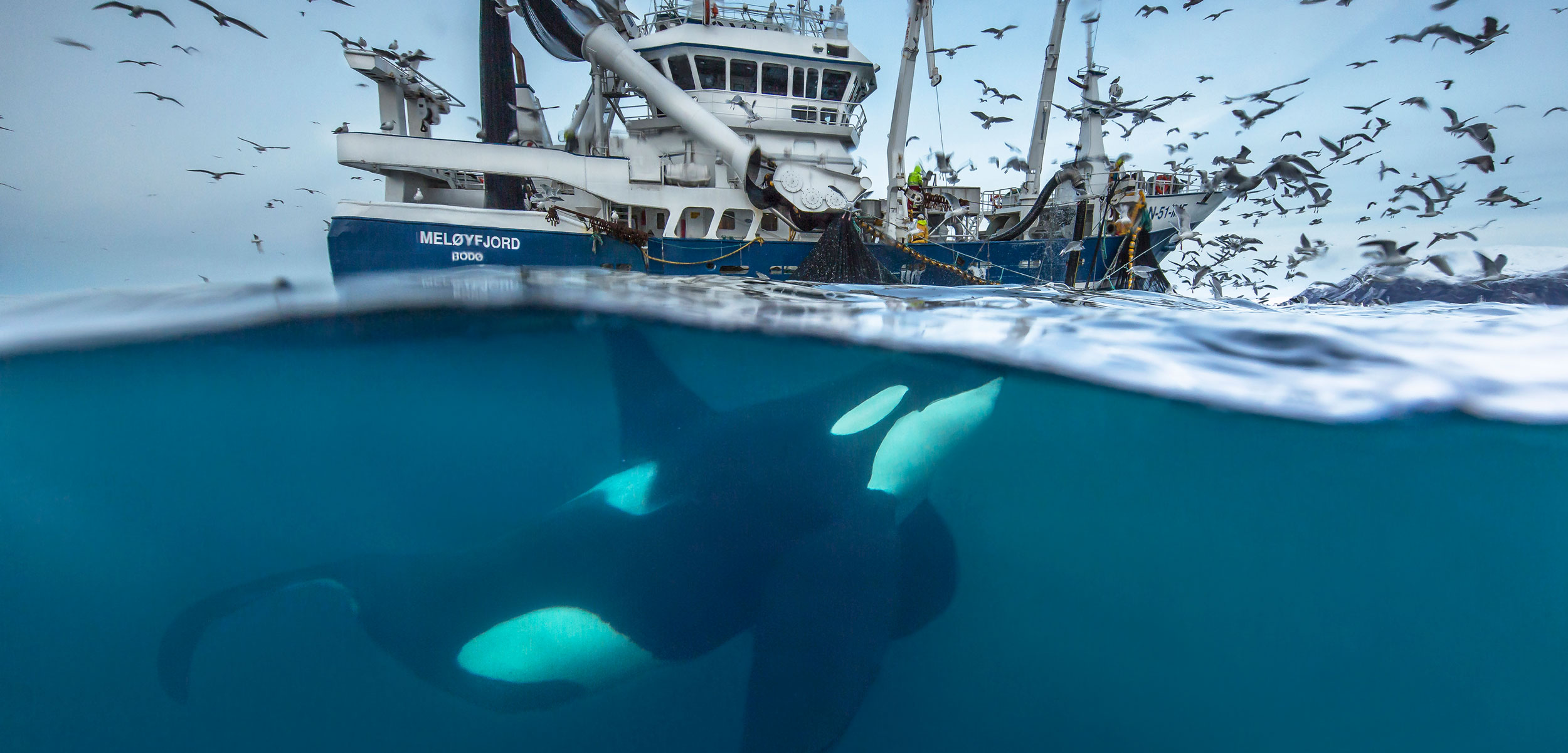Clever Whales and the Violent Fight for Fish on the Line
As a commercial fisher, I’ve watched colleagues shoot at whales looting from their lines. Here’s why everyone loses when that happens.
Article body copy
Congratulations to Nick Rahaim for winning the second place award in the Outstanding Feature Story, Small category at the 22nd Annual SEJ Awards for Reporting on the Environment.
As I coiled rope on the deck of a commercial fishing boat in the western Gulf of Alaska, I felt the sudden thud of a revolver reverberate in my chest. I wheeled around as a crewmate fired more bullets; a round of buckshot followed, from a shotgun held by my captain. I’d known their anger was growing as sperm whales ate our catch but hadn’t expected they would vent their frustrations with live ammunition. I looked out and saw a sperm whale crest the surface for air around 20 meters away, seemingly unfazed by the heavy fire.
It was early spring 2013, and I was sore, exhausted, and cold. After working 20 hours a day for more than a week, my crewmates and I still owed the boat money because sperm whales had dined on nearly all the sablefish hanging from our hooks as we burned fuel and ate food—both of which came out of our pay. We were using longline gear, essentially a kilometers-long rope with baited hooks spaced at intervals, and all that we pulled from the depths were bent hooks and the occasional disembodied sablefish head.
In videos taken by researchers over the years, the whales are surprisingly graceful—giants weighing 15 to 40 tonnes gently biting half-a-meter-long sablefish off the hooks. Sometimes sperm whales will rake the rope as it’s being hauled in, letting the hooks run over their lower teeth, with the fish popping off upon contact. Other times, the whales will grab a taut rope in their mouth and pluck it like a guitar string, whipping fish off the hooks from the vibration.
Underwater footage from the Southeast Alaska Sperm Whale Avoidance Project shows a sperm whale attempting to remove a sablefish from a line.
Fatigue and financial loss made me indifferent to the agile intelligence displayed below my feet, but seeing my coworkers shoot at the largest species of toothed whales on the planet—an illegal act that could lead to a steep fine and a year in jail in the United States—revolted me. Yet I knew my protests would be futile, and I was more than a day’s boat ride from the nearest port.
In the Gulf of Alaska, as well as in longline fisheries throughout the world from the Bering Sea to the Antarctic and tropical waters between, toothed whales—that is, any whale that feeds with teeth instead of baleen, such as sperm, pilot, and killer whales—are learning to see fishers and their gear as a source of an easy meal. Scientists researching this behavior, known as depredation, say whales are increasingly eating lucrative catches right off the hook instead of foraging naturally. There’s no easy way to stop it, and the behavior is spreading through whale culture. Whales’ penchant for hooked fish might be the biggest fisheries story that hardly anyone knows about.
“Over the past five to 10 years, it has become a big issue in more and more fisheries,” says Paul Tixier, a biologist with the French National Research Institute for Sustainable Development, who has written dozens of papers on depredation with a focus on sperm and killer whales targeting Patagonian toothfish in southern oceans.
Sharks, seals, and sea lions are also known to depredate, but whales cause the biggest problems for longline fisheries.
Andrew Read, director of the Duke Marine Lab in North Carolina, was one of the first in the scientific community to bring attention to the growing conflict with a 2008 article, “The Looming Crisis: Interactions Between Marine Mammals and Fisheries,” and he has seen the problem only increase since then. “It’s the big untold story right now,” Read says. “It results in significant economic loss to fishermen and often retaliatory measures to whales.”
It’s hard to fault an intelligent animal for maximizing an opportunity—who among us would pass up a free meal to go scrounge around in the kitchen for dinner instead? But as whales and fishers intersect, there’s bound to be more conflict. The fishers, many of whom are already challenged with falling catch rates and profit margins, risk losing even more income, and depredating whales risk getting fatally shot or becoming hooked themselves, which some scientists fear could limit their population growth. And in the middle of it all, target fish species like sablefish, tuna, and Patagonian toothfish, already pinched by climate change and industrial fishing, face extra pressure. As depredation becomes a bigger—and better-known—problem, the sustainability of some fisheries, livelihoods, and whale populations is in question.
I’ve worked in nearly a dozen fisheries in the United States for more than a decade and have used a variety of gear—including seines, gill nets, traps, and longlines—from Southern California to the Gulf of Alaska. While every fishing method has environmental impacts, in my experience nothing creates a more immediate behavioral conflict between humans and whales than longlines.
On other longlining trips I’ve been on in the Gulf of Alaska, sperm whales have eaten a day’s catch, which could be worth tens of thousands of dollars. But the spring 2013 trip and a few others on the same boat that season were the only times I’ve witnessed fishers shoot in response. Other crewmates and friends in the industry have told similar stories of retaliation, but with consequences so high and the look so bad, it’s rarely spoken of. Losing money and time is frustrating, but most fishers I know now begrudgingly accept depredation as a cost of doing business at sea.
Depredation, though little known, isn’t new. In 1904, a sperm whale was found off the Shetland Islands with fishhooks in its stomach, presumably from depredation. Whales were first directly observed eating fish off hooks in the 1950s in various global fisheries. Since then, the behavior has grown from a minor nuisance to a serious problem.
A common explanation among fishers in Alaska is that after the International Whaling Commission’s 1986 moratorium on commercial whaling, a generation of sperm whales grew up without fear of boats. While there’s truth to that, the situation is far more complex.
In the 1990s, the use of longlines exploded in fisheries throughout the world, just as populations of many whale species began rebounding from a century of slaughter and many fish stocks began to show signs of overfishing. There are two main kinds of longlines used in global fisheries. Demersal longlines, which can be anywhere from one to 40 kilometers long with thousands of hooks, often baited by hand, target fish close to the ocean floor, including sablefish and halibut in the North Pacific and Patagonian toothfish farther south. Pelagic longlines are designed instead for open-ocean species, typically tuna and swordfish. They include up to 80 kilometers of rope suspended from a series of buoys as far as 600 meters below the surface and have hundreds, if not thousands, of baited hooks.
One reason for the increase in longlines was that, as of 1992, the United Nations General Assembly banned drift nets longer than 2.5 kilometers on the high seas because of their high rates of sea turtle and cetacean by-catch and death. Pelagic longlines seemed like an environmentally friendly alternative, but they created new opportunities for toothed whales to feed—and new ways for them to die.
While sperm whales are at the center of the conflict in the Gulf of Alaska’s sablefish fishery, it’s killer whales that have caused the most problems for people catching sablefish in the Aleutian Islands and the Bering Sea. Killer whales and false killer whales also target tuna and swordfish fisheries in the southern hemisphere off the coasts of Brazil, Uruguay, and Argentina. Off the mid-Atlantic coast of the United States, short-finned pilot whales target tuna and swordfish. Farther south, in subantarctic waters, killer whales and sperm whales target Patagonian toothfish. In the tropical tuna fisheries of the Pacific Ocean, the false killer whale is often the species most likely found depredating.
One of the biggest difficulties for fishers and scientists hoping to mitigate depredation is that there’s still uncertainty as to why whales choose to feed this way. “The dots are not fully connected yet,” says Jan Straley, a principal investigator of the Sitka-based Southeast Alaska Sperm Whale Avoidance Project (SEASWAP), who has researched depredation in the Gulf of Alaska for about two decades.
Is the behavior simply opportunistic—akin to bears scoring easy calories in dumpsters? Is it driven by direct competition with fishers over a common prey? Or is it a response to the growing difficulty of finding enough prey in a stressed ecosystem? In some regions, the working hypothesis seems to include all of the above, while in other areas, it’s more specific.
In the Gulf of Alaska, sperm whales forage on sablefish as a natural part of their diet. The sablefish population here has never been considered overfished, so biologists think it’s unlikely that direct competition is the primary driver of depredation. Gobbling sablefish off fishing gear is simply the most efficient way to eat them. A 2012 study by SEASWAP found that sperm whales depredating sablefish off longline gear in the Gulf of Alaska consume the same number of calories in just three hours as they would by foraging naturally for up to 12 hours.
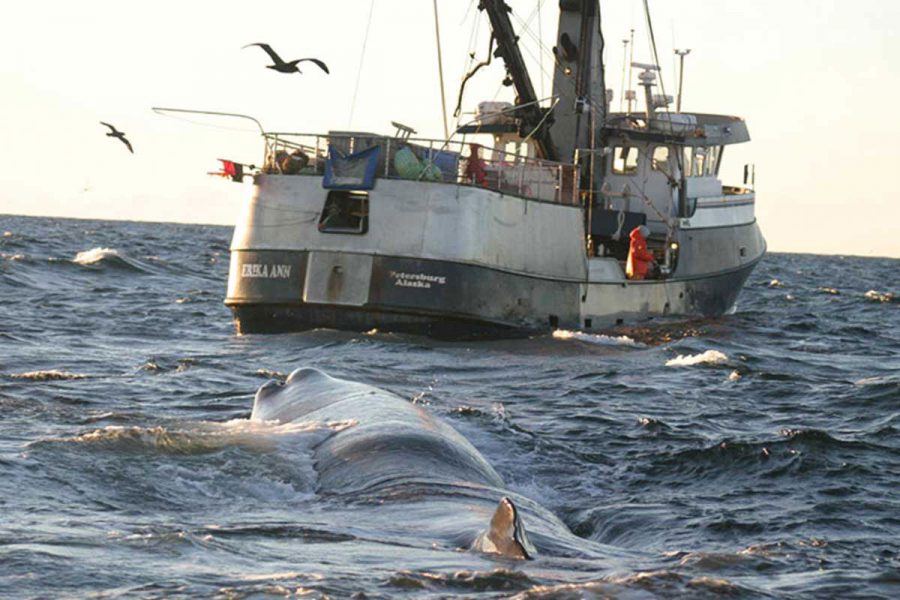
A sperm whale follows a sablefish longliner from Alaska. Photo by NOAA Southwest Fisheries Science Center
On one fishing trip I’ve been on, we found sperm whales sleeping by our buoys, seemingly waiting for us to pull up the gear so they could eat. Why not nap where you know you’ll be woken up to a meal? Other times, whales will show up an hour after us, likely having followed the distinct sound of a boat hauling in gear.
A study Straley collaborated on, which involved putting bioacoustic tags on seven sperm whales, suggests the whales are able to calculate the cost-benefit of depredating on the fly by using acoustic cues. If the sound of a boat motoring to fishing grounds is coming from within 55 kilometers—a six-hour swim—a sperm whale seems to deem that it’s worth burning the calories to travel there and depredate. If the distance is any greater, the whales stay put. But if fishers have already begun hauling up their catch—a process that takes around three hours—the whales only swim up to two hours for the chance of depredating. They “can do the math,” Straley says.
It’s possible that a change in management of the Gulf of Alaska sablefish stock also helped sperm whales master depredation. The fishery was originally managed as a derby—fishers had a limited time on the water to catch as many fish as they could for the entire year. In 1995, a catch-share system was implemented, giving fishers about eight months to catch their quotas instead. This led to a 70 percent reduction in the fishing fleet and helped regulators manage stocks, but it also allowed sperm whales more time to familiarize themselves with longline gear.
In toothfish fisheries in the southern oceans, there is a higher likelihood that direct competition over prey is contributing to depredation. In the 1990s, Patagonian toothfish (marketed as Chilean sea bass) exploded worldwide as a meaty yet tender and flaky alternative to the standard cod, tuna, and salmon found in most fishmongers’ display cases. Markets developed faster than regulation, leading to severe overfishing.
Until recently, scientists were unsure if killer whales naturally prey on Patagonian toothfish, but in 2019, Tixier and his colleagues published stable isotopic evidence proving that they do. “The fact that toothfish was made scarcer by illegal fishing in the early years [1996 to 2000] may have made the whales more inclined to switch to depredation,” Tixier says, but adds they may have simply been interested in an easy meal. The fishery is now under strict quotas in both national and international waters, but some stocks have yet to fully rebound.
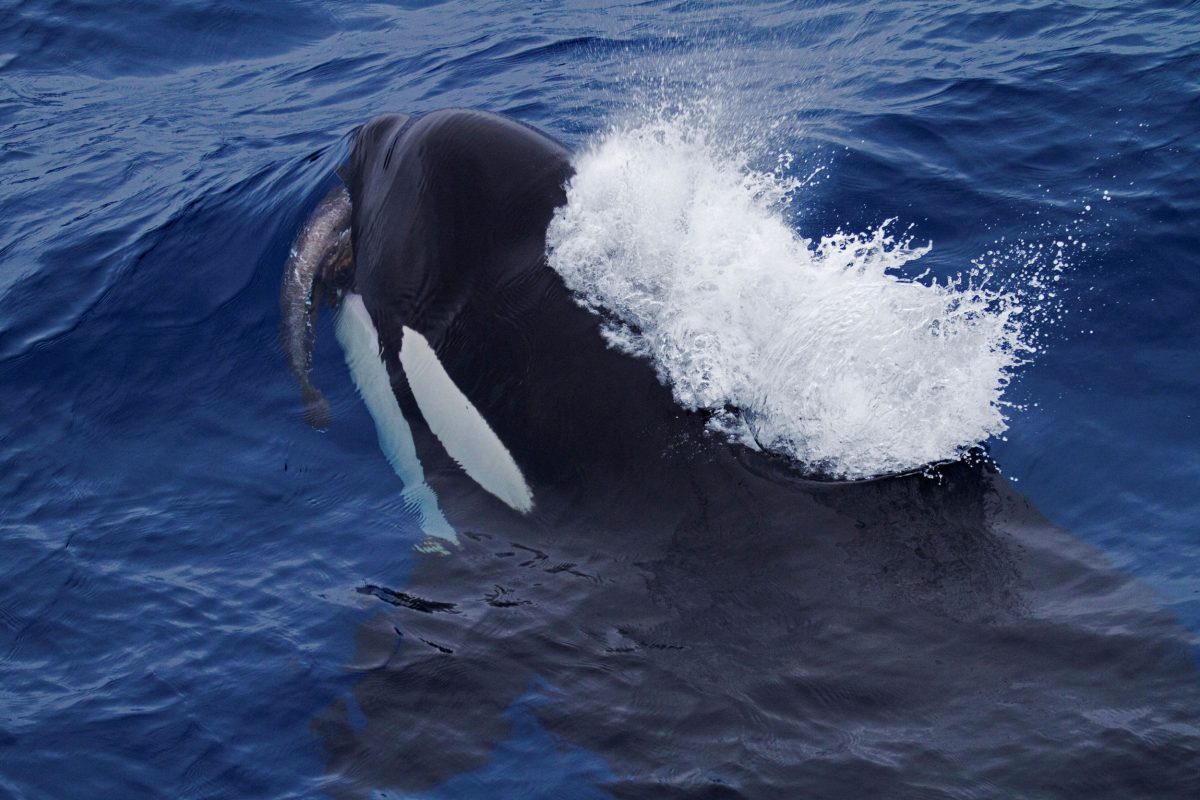
A killer whale makes off with a Patagonian toothfish after pulling it from a fishing hook in the Crozet Islands in the Indian Ocean. Photo by Paul Tixier
In Atlantic pelagic longline fisheries, something very different is afoot—through depredation, short-finned pilot whales are finding a whole new food source. Short-finned pilot whales feed in the same high-productivity areas as tuna and swordfish, often on the same prey, but these three predators don’t naturally eat one another.
“Pilot whales can’t catch tuna; they’re too fast,” Read says. “But through depredation they have done something remarkable and gone up a trophic level—now they’re eating their competition.”
Depredation of tuna and swordfish by short-finned pilot whales in the Atlantic is “episodic,” Read says, and is most common from October to December. Scientists don’t yet know what specific ecological factors cause this shift. The abundance of deep-water squid, the primary prey of short-finned pilot whales, is unknown, but Read says the working hypothesis is that as the squid population goes down, depredation goes up.
If climate change–altered ecosystems put downward pressure on squid populations, short-finned pilot whales might increasingly look to fishing boats for sustenance.
Regardless of why toothed whales are targeting longline boats for food, it’s likely the behavior has measurable impacts on the species they’re eating. Most longline fisheries are managed by quota systems with fishers having a set amount of fish to catch based on the estimated size of the stock. If, for example, a fishing boat longlining in the Gulf of Alaska is permitted to take 10 tonnes of sablefish but sperm whales ate two tonnes along the way, that would mean 12 tonnes of sablefish died. What we don’t know is whether the whales would have naturally hunted and eaten that much anyway, or if depredation allows gluttony and excess sablefish mortality.
Depredation has yet to imperil the health of the fish stocks in question, but it has prompted some fisheries managers to lower quotas out of concern for sustainability. After learning that sperm whales eat around 2.5 percent of the total sablefish harvest in Alaska, the National Oceanic and Atmospheric Administration (NOAA) reduced the total quota for the fishery by one to two percent in recent years, says Dana Hanselman, division director for NOAA’s Auke Bay Laboratories in southeast Alaska.
In the Crozet Islands, a French subantarctic territory in the Indian Ocean, killer and sperm whales eat 30 percent of the total toothfish catch, Tixier says. French fishery managers have adjusted the quota accordingly, allowing fishers to take 300 tonnes less in 2010 than they had in 2009. Other regions where toothfish are caught have done the same.
Although fishers can catch their allotted amount under the quota system, we lose bait, food, fuel, and time if hampered by depredation. Deckhands on US fishing boats often earn a share of net fishing profits, typically between one and 10 percent. No profit means no money. Once, I looked at my itemized settlement at the end of a longline season and found there were a few trips that cost me. Whales ate the catch, but I was still on the hook for my share of the costs, which were docked from my pay when we finally caught fish.
Looking at the scientific literature, there’s no easy number or even a single method to determine the economic costs of depredation in global fisheries. Depending on the study, costs are broken down per hook, per set, per day, per year, or over a multiyear period.
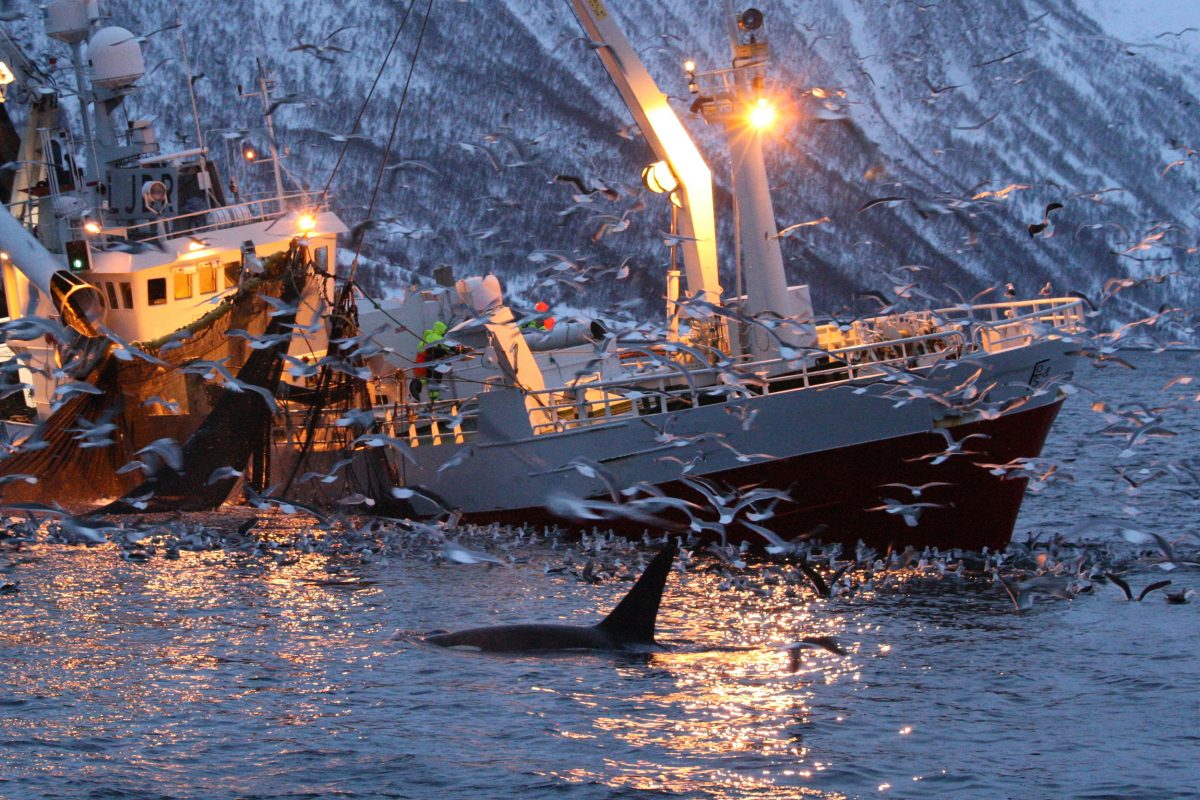
Hungry whales and hardworking fishers are often chasing the same stocks. Here, a killer whale feeds on herring alongside a fishing boat (not a longliner) near Kaldfjord, Norway. Photo by Alessandro De Maddalena/Shutterstock
A 2012 literature review found daily financial losses due to whales dining off hooked fish to be from US $1,034 to $8,495 in pelagic longline fisheries globally. In another study, awaiting peer review, on depredation by false killer whales on tuna in the Hawaiian pelagic longline fishery, Joseph Fader, a PhD candidate at Duke University in North Carolina, found fishers lost $1.1-million annually. And in the Crozet Islands, researchers found depredating killer and sperm whales cost French fishers of Patagonian toothfish around $32-million between 2003 and 2012.
There are significant differences that can make the costs manageable in some cases and unsustainable in others. In Seychelles, for example, fishing operations are largely artisanal, and in the Gulf of Alaska, longline boats are often captained by an owner/operator—small operations like these are less likely to recover from loss than well-financed industrial operations. Faced with these setbacks, fishers are taking action—most with non-lethal mitigation strategies, some with guns and explosives.
Sharing the experience I had with frustrated former crewmates shooting whales in Alaska is sure to burn bridges. One biologist, who lives in a small fishing community and is protective of the industry’s reputation, even asked me not to mention the incident, and added, as a guised threat, that I could face legal consequences for being a witness and reporter.
On the water, I’ve occasionally witnessed other illegal acts and unethical behavior targeting marine mammals, but to be fair, most fishers I’ve encountered don’t shoot them. NOAA’s records indicate that there hasn’t been a single sperm whale found stranded in the Gulf of Alaska with a gunshot wound. It’s also hard to kill a sperm whale with a gun—any shooting-related death would likely be from an infection of the wound. That said, the NOAA law enforcement division, which tracks human-caused fatalities to marine mammals, reports that from 2015 to 2020 in the United States, 16 other cetaceans were found dead with gunshot wounds.
Around the Crozet Islands, biologists saw a 60 percent decline in the killer whale population from 1988 to 2000 and largely attributed the drop to illegal fishing vessels in the area using firearms and explosives to deter the whales from their toothfish, says Tixier. Increased enforcement since then has improved the situation, but he suspects some lethal retaliation from illegal fishing vessels continues. “We’re still observing some unexplained mortality on that killer whale population,” he says.
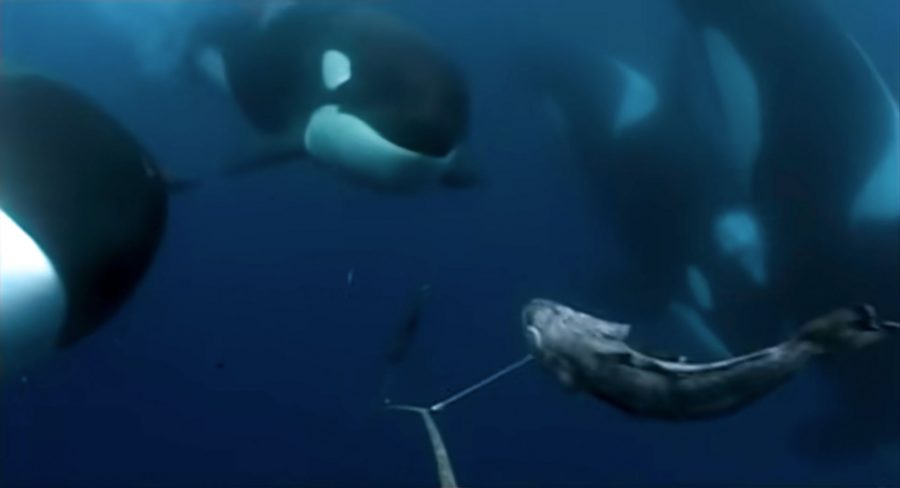
Killer whales near the Crozet Islands approach a fishing line to snag a toothfish. Photo by Bertrand Loyer
The only instance on record of a fisher being arrested and prosecuted for shooting a whale in the United States occurred off New Jersey. A short-finned pilot whale washed up on a New Jersey beach in 2011, clinging to life with a bullet lodged in its jaw. It died soon after from infection. Through ballistic analysis, authorities determined a suspect: a longline tuna fisherman who had recently posted a photo of a tuna head on Facebook with the caption, “Thanks a lot pilot whales.” Charges were eventually dismissed in federal court; the attorney’s office that prosecuted the case declined to provide details on why the case was dropped.
Guns and explosives present animal welfare and legal issues, but the biggest threat to depredating whales isn’t retaliation, it’s becoming by-catch. While depredating killer and sperm whales in upper latitudes may become entangled in ropes, which can be deadly, they’re not likely to get stuck on a hook—the demersal longline gear is too lightweight for their size. False killer whales, short-finned pilot whales, and other whales depredating in pelagic longline fisheries, on the other hand, can easily get hooked while trying to snag a meal. They can be released with minimal injury, but may be too weak to survive after hanging from the line.
In the United States, NOAA attempts to limit whale mortality from pelagic longlines in various ways. In Hawai‘i, that includes requiring fishers to use certain gear, such as circle hooks weak enough to break under the weight of a whale; having observers on board for a portion of fishing voyages to monitor activity; and implementing closures when the rate of fatal by-catch exceeds an established threshold. On the Atlantic coast, measures include limiting the length of longlines to 37 kilometers.
One little-known aspect of the US Marine Mammal Protection Act is that it allows for a “sustainable” rate of unintended marine mammal mortality. This is the rate at which incidental death can occur without harming population growth. In the northwest Atlantic, for example, 23.6 short-finned pilot whales out of an estimated population of at least 23,637 could be accidentally injured or killed without penalty in 2020. That number shifts according to the population size of the species.
The subpopulation of false killer whales known to depredate and become by-catch in Hawaiian longline fisheries, on the other hand, is endangered, with a population of less than 170 whales. Even a single whale becoming by-catch is considered too many. When one false killer whale was killed and another seriously injured in 2019, regulators closed a large portion of the southern waters off the Hawaiian Islands to longlining for the remainder of the year.
In less tightly regulated fisheries, particularly on the high seas, the true number of whale deaths from by-catch is hazy. The Western and Central Pacific Fisheries Commission, which oversees the most productive tuna region on Earth, in the Pacific Ocean, indicates that between 2015 and 2020, on-board observers documented 266 cetaceans hooked and released alive from longlines, 56 more that died, and 10 others of unknown life status. The commission requires that observers cover five percent of the fishery, but many member nations fall short, so the actual number of dead or injured cetaceans is almost certainly magnitudes greater.
There is no easy solution to depredation and the by-catch it produces, but in the Gulf of Alaska, some sablefish fishers are shifting to using pots to mitigate depredation. Pots—essentially baited traps—are common for catching crab, lobster, and other crustaceans, and now sablefish. The benefit is that sperm whales have yet to learn how to eat fish protected by metal and nylon mesh.
A coalition of small-boat fishers opposes the 2015 policy change that allowed the use of sablefish pots in the Gulf of Alaska because the gear is too big to easily stack on small vessels and is too heavy for their hydraulic systems to pull to the surface. They also fear, with some evidence, that as other fishers switch, sperm whales will become an even greater problem for those continuing to use traditional gear.
Last fall, while I was longlining for sablefish, the captain tried out new gear called slinky pots. The lightweight, collapsible traps shaped like giant slinky toys are covered in nylon mesh and can be set on a longline. Unlike traditional pot gear, they are light enough for a small boat’s hydraulic system. Unfortunately, in our case, the catch rate was a lot lower with them, and they seemed to trap smaller, less valuable fish. But more and more vessels are starting to use slinky pots as their primary gear with some success. In 2021, traps—both slinky and traditional pot gear—accounted for 63 percent of sablefish harvested in the Gulf of Alaska, up from nine percent in 2018. Statewide, just over half of the sablefish catch is taken with trap gear.
Traditional pots have also been tested in toothfish fisheries, Tixier says, but the catch rate is much lower than with the usual demersal longlining hooks, so the cost-benefit ratio doesn’t yet work, even when depredation is factored in.
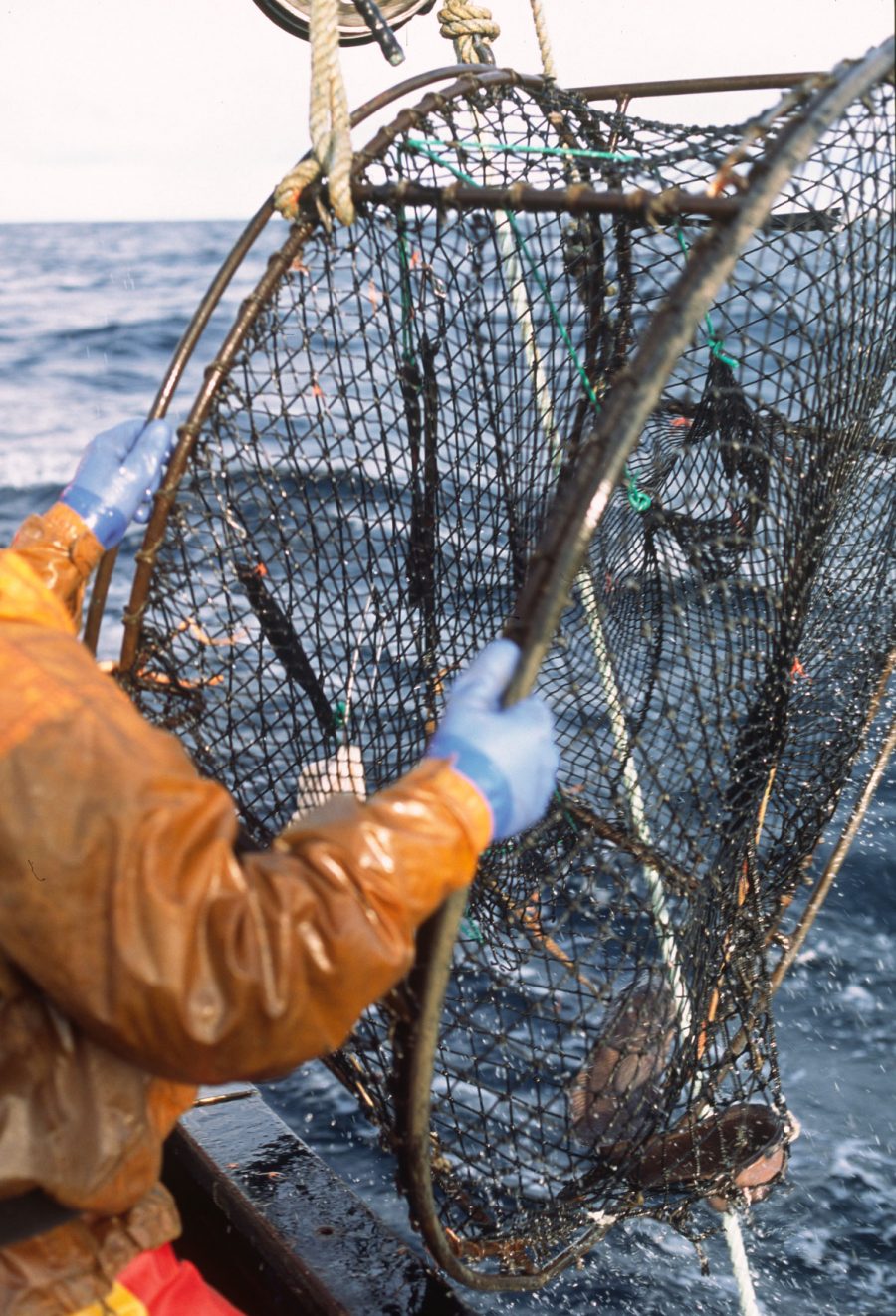
Fishers in the Gulf of Alaska are increasingly turning to traps, known as pots, instead of longlines in an effort to reduce depredation on sablefish catches. Photo by Misha Dumov/Stocksy
Traps don’t work at all in pelagic longline fisheries, as gear is suspended in the water column, not anchored to the ocean floor. Various deterrent systems, often known as socks and spiders, have been tested for pelagic longlines. Once a fish bites the hook, a trigger system releases a nylon sleeve or metal chains to cover the catch. They have been moderately effective, but can be cumbersome to use, requiring both an extra deckhand and significantly more time, making them cost prohibitive.
Researchers have also tried blasting whales with high-pitched noises from acoustic harassment and deterrence devices, but many whales quickly become habituated to the noise.
In the Gulf of Alaska, SEASWAP has experimented with sound—though in much different ways. Straley and other researchers determined that the sound of a boat’s propeller being engaged and disengaged alerts sperm whales to longlines being hauled to the surface. So researchers are using decoys that emit a recording of that sound to lure sperm whales away from the actual longline. The technique has proved less successful than hoped. “Sperm whales are just so smart and clever,” Straley says. “I believe they know what we’re going to do before we do.”
SEASWAP is also working with acoustic tracking, which involves using hydrophones set on lines or towed behind a fishing vessel to pick up the clicks and creaks of sperm whales in real time and alert fishers if they’re nearby. This has promise, says Straley, but she’s dubious about finding permanent solutions.
While my captain didn’t like the yield from slinky pots, there was a moment last fall during a separate trip when he probably wished we had set them instead of hooks. Four sperm whales appeared and began following our boat a few kilometers from our gear. The day prior, we’d had a good haul of sablefish and were hoping we’d catch our quota in just a few days, but whales ate almost every sablefish on the line. Interestingly, they left grenadier, rockfish, and other by-catch on the hooks—sperm whales are picky. Luckily for my conscience and the whales, I worked for a captain who, while an avid hunter, did not carry guns on board. We did the only advisable thing when a pod of sperm whales targeting fishing gear is nearby—gave up on that location and drove 80 kilometers overnight to a new fishing spot, hoping they wouldn’t follow. In nearly every longline fishery on the planet, scientists and fishers have found the best way to stop depredation is to avoid whales.
Reducing how much time a line is in the water and hauling it in at a faster pace are other proven mitigation strategies because they reduce how much time whales have for depredation. Using shorter lines helps on both accounts. None of that seems too much to ask of fishers, but as a deckhand, I can’t help but think of the extra strain on my body from trying to catch the same number of fish with these constraints.
In longline fisheries around the world, whales will likely continue to outwit fishers and scientists, even as they face death and injury from gunfire, explosives, and encounters with gear. It’s their ocean, so it’s incumbent upon us to find solutions that work for them, and us. But the challenge is immense—we’re dealing with intelligent creatures.
Every potential solution to depredation seems to create new problems, and I recently experienced one of them. While I was longlining for Pacific halibut in the Gulf of Alaska in September, three sperm whales lingered around our boat.
Pacific halibut are caught in shallower water than sablefish, but the fishing grounds for the two species are relatively close, often just a few kilometers apart. In my experience, sperm whales have typically ignored halibut. But as we hauled up our lines that day, we saw signs that that was changing.
It may be that the increasing number of boats using traps and slinky pots has reduced the amount of sablefish that sperm whales can depredate, so they’re looking elsewhere for an easy meal.
Some fish were missing, apparently pulled off the hooks, and a number of the fish we hauled in had the imprint of large teeth in their flesh, rendering them unsellable. Perhaps the notoriously picky whales are hungry but haven’t quite yet acquired a taste for halibut.

